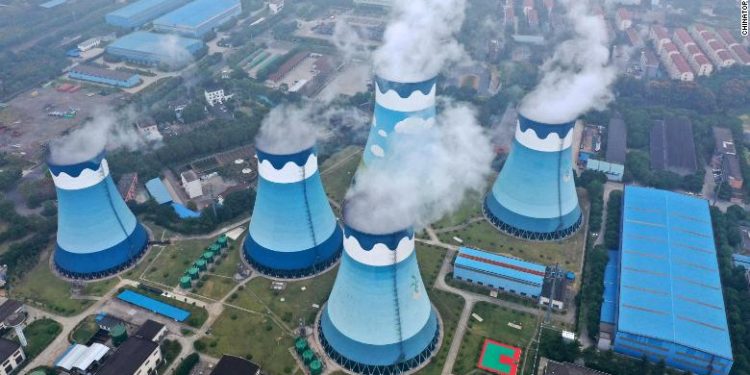By Miguel Sorans, a leader of Socialist Left/Left Front–Unity (IS/FITU) and the IWU-FI.
11 October 2021
An energy shortage is growing in China and Europe, which may spread to the rest of the world. In Lebanon, there was a power cut in the entire country for several days. This is combined with rising market prices for gas, oil, coal and raw materials. The most serious point is China, which has a semi-paralysed industry in 20 provinces, with power cuts. What causes this recent crisis?
Undoubtedly, this shows that the most serious crisis of the world capitalist economy, deepened by the pandemic of COVID-19 at the beginning of 2020, is still latent. It belies previous announcements by the IMF, the World Bank, and other agencies of imperialism, of a supposed overcoming of the crisis.
China dimly lit
China is at the turn of an enormous crisis. It had already had a first, yellow alert, with the crisis of the real estate giant Evergrande, one of the big Chinese multinationals that have gone bankrupt . And now, as a headline in the bourgeois press put it, “forget Evergrande, China is facing an energy crisis that could put the world on the ropes” (El Economista.es, 27 September 2021).
Among the provinces most affected are Jiangsu, Zhejiang and Guangdong, the trio of industrial powers that account for almost a third of China’s economy. The consequence of power rationing, mainly from power cuts, is leading to partial or total shutdowns of factories and power outages in homes. From aluminium smelters, affecting the price of metals, textile producers, soya processing plants, to factories that belong to the Chinese companies. And also, factories belonging to foreign multinationals that supply components for the car industry and the technology branches in Europe and the world. This opens the prospect of a slowdown in production and the beginning of a shortage of these parts.
Among the multinationals concerned are the entire automotive industry, mainly European, Apple and Tesla, which have their suppliers in China. It would partially cut off the supply chain of electronic products, and car parts and even of the finished units that are sent to Europe. And this comes when the northern hemisphere is on the verge of winter, which would jeopardise the heating of millions and millions of homes. The price of liquefied natural gas (LNG) on the world market is rising, as is the price of oil, even though China is not a major producer of oil and gas. The price of coal, of which China is a major consumer, has also risen. Although it is a major producer, it does not meet domestic needs and has to import. Because of the shortage of natural gas, it has resumed importing coal when it had planned to reduce its use, because of international pressures and global warming. In recent days, ships carrying 450,000 tons of coal from Australia entered the country.
In China, unlike European capitalism that is producing a tariff increase so that this price crisis is paid by the working class and the popular sectors, the dictatorship of the Communist Party of China (CPC) is trying to avoid producing a very strong tariff increase for fear of the growth of protests and a social rebellion . The first signs have appeared in the face of the ongoing crisis of the real estate company Evergrande, which has left millions of savers without their homes because of this swindle.
For months now, the capitalist dictatorship in China, aware of the bad social climate, has been trying to put pressure on the big Chinese multinationals to reduce their profits. The president himself, Xi Jinping, has launched the slogan of seeking “common prosperity”, as part of a “double-talk” that aims to present itself to the masses as “confronting the rich”. Such is the crisis that in the same speech, Xi warned of the danger that, despite China’s successes, it could collapse as the former USSR did: “it collapsed, mainly because the Communist Party of the Soviet Union separated itself from the people and became a group of privileged bureaucrats concerned only with protecting their interests” (July speech to party members). He made a reckless comparison and a very strong warning, which is reflecting that a serious crisis is developing in China, which can be fuelled by the energy crisis.
Energy crisis spreads to Europe
Europe and the UK are also reflecting the increase in LNG gas and oil prices, which have risen by 500 per cent since last year. It should be noted that Europe, except for Norway, does not produce gas and has to import 70 per cent of what it needs for industry and households. Gas prices soared to a record high of 115 dollars per megawatt-hour, a rise that is also combined with that of the price of oil, which reached its highest level since November 2014. Crude oil, for example, is almost 80 dollars a barrel in the US, while Brent crude, the European benchmark, has risen to 82.87 dollars. This is producing, in different countries, an increase in popular tariffs. One country with the most stratospheric tariff increases in Spain, which is much more dependent on gas for its electricity production than any other European country. But none of them is safe. France and Italy, for example, also increased their tariffs.
Causes of rising gas and oil prices and energy shortages
There is a combination of events leading to shortages of gas, oil, coal and rising prices for these raw materials. The root cause is the crisis that the world capitalist system is going through, which is leading to a free-for-all for the multinationals, mainly the oil and gas producers, and also the coal producers who want to recover their profits.
The reality is not that oil or gas is “running out”, but it is the role of the multinationals. The big producers, as production is reactivated again after the peak of the pandemic, want to recover from the losses they incurred because of the partial decline of industrial and service sectors. For example, maritime transport, aeroplanes and buses partially stopped working, which led to a decrease in the consumption of energy, gas and fuel. Sometimes the oil and gas multinationals no longer knew where to store their surpluses.
Now the big multinationals want to recoup these losses and make the world working class and the peoples of the world pay for them. The big gas producers like the US, Russia and Qatar, among others, have no shortages, but these energy powers and their multinationals have refused to increase their production. And they encourage gas, oil and coal prices to rise. There is the speculative game on the stock exchanges all over the world, where the big bourgeoisie bets on the stock exchanges to increase the prices. Because the prices of raw materials are fixed in Chicago, Wall Street, London or Hong Kong, then there is also an increase by the way of looking for speculative fast profits at the cost of this chaos that they are provoking. But that leads to the suffering of the masses, to no heating and an increase of tariffs to be paid by the millions and millions of the dispossessed of the world, the working class and the popular sectors.
A growing environmental crisis with increased use of coal
The other factor, which also continues to affect the masses and which shows the cynicism of imperialism and its big “climate” events, where they say they are fighting global warming, is the lie that they have not lowered, for example, coal consumption. Coal is still a fundamental product to produce energy, especially in China, but also in Europe and Australia. They still talk about a plan to eliminate it.
For example, the United Kingdom, which, faced with the emergency, is reactivating coal-fired power stations to guarantee the country’s electricity supplies. The British government had announced a plan to phase out coal entirely by 2024, and it is the country organising COP26, the world climate conference in Glasgow in November. And it was part of the talk of achieving carbon neutrality by 2050 when already environmental movements led in Europe by Swedish teenager Greta Thunberg made a speech recently that defined the plan as the “blah blah blah” of imperialism.
China is the highest point because it is the big industrial manufacturing country that bases its electricity production essentially on coal when it had also announced that it will cut production and use of this pollutant.
56 per cent of China’s energy comes from coal, being the world’s largest coal consumer, and it imported almost 198 million tonnes in the first eight months of 2021. So the ratification of its massive use, both in China and in Europe and other countries, will only encourage what has also been shown in the last year, the worsening of the global climate crisis. While capitalist business continues, because coal producers, such as China and Australia, have increased their prices in a sidereal way.
In short, the so-called “energy shortage crisis” is developing, expressed in higher prices for gas, oil, coal and raw materials. It is another chapter of the capitalist crisis and will encourage inter-bourgeois friction. But those who will suffer most are the masses of the world. Billions will have more suffering for their daily life and will see the fall of their standard of living, because many factories will be closing down in China and other parts of the world, totally or partially; As the wage level is reduced, the governments apply tariff increases to make the working class pay for the crisis. So, in this perspective, what we will continue to see are new expressions of social confrontation against these austerity plans, tariff increases, wage and pension cuts. And from the IWU-FI and the entire militant trade union movement worldwide, we call for mobilisation to confront this counter-offensive of the multinationals and imperialism. Demonstrations of this have been taking place for some time with the popular rebellions in Latin America, such as in Colombia and Chile. In Brazil, the demonstrations against Bolsonaro or the trade union strikes in France and Italy, the railway strike in Germany. That will be the way to confront this new attempt to make the working class pay for the capitalist crisis.
1. See article by Jose Castillo, in International Correspondence #48.
2. See the article “100 years after its foundation, the CP of China leads a capitalist dictatorship“.













